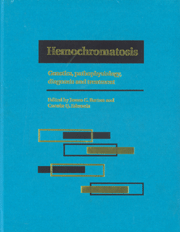Book contents
- Frontmatter
- Contents
- List of contributors
- Foreword
- Part I Introduction to hemochromatosis
- Part II Genetics of hemochromatosis
- Part III Metal absorption and metabolism in hemochromatosis
- Part IV Diagnostic techniques for iron overload
- 18 Liver biopsy in hemochromatosis
- 19 Histochemistry of iron and iron-associated proteins in hemochromatosis
- 20 Computed tomography and magnetic resonance imaging in the diagnosis of hemochromatosis
- Part V Complications of iron overload
- Part VI Therapy of hemochromatosis and iron overload
- Part VII Infections and immunity in hemochromatosis
- Part VIII Hemochromatosis heterozygotes
- Part IX Relationship of hemochromatosis to other disorders
- Part X Animal models of hemochromatosis and iron overload
- Part XI Screening for hemochromatosis
- Part XII Hemochromatosis: societal and ethical issues
- Part XIII Final issues
- Index
19 - Histochemistry of iron and iron-associated proteins in hemochromatosis
from Part IV - Diagnostic techniques for iron overload
Published online by Cambridge University Press: 05 August 2011
- Frontmatter
- Contents
- List of contributors
- Foreword
- Part I Introduction to hemochromatosis
- Part II Genetics of hemochromatosis
- Part III Metal absorption and metabolism in hemochromatosis
- Part IV Diagnostic techniques for iron overload
- 18 Liver biopsy in hemochromatosis
- 19 Histochemistry of iron and iron-associated proteins in hemochromatosis
- 20 Computed tomography and magnetic resonance imaging in the diagnosis of hemochromatosis
- Part V Complications of iron overload
- Part VI Therapy of hemochromatosis and iron overload
- Part VII Infections and immunity in hemochromatosis
- Part VIII Hemochromatosis heterozygotes
- Part IX Relationship of hemochromatosis to other disorders
- Part X Animal models of hemochromatosis and iron overload
- Part XI Screening for hemochromatosis
- Part XII Hemochromatosis: societal and ethical issues
- Part XIII Final issues
- Index
Summary
Introduction
Of the transition and heavy metals important for normal metabolism, iron is the most prevalent. In living organisms, iron is almost always present as the ferrous (Fe2+) or ferric (Fe3+) form. Because each of these ionic species is highly reactive, most iron in biological systems is bound to transport, regulatory, or storage proteins, or exists as a component of iron-porphyrin complexes or metalloproteins. Histochemical analysis of iron and iron-associated proteins in normal human and animal tissues permits an understanding of normal iron absorption and metabolism, and the distribution of iron and its chemical forms among cell types and subcellular organelles.
In hemochromatosis, the absorption of iron is inappropriately great for body iron content. Because mechanisms to excrete iron are limited, most persons with hemochromatosis eventually develop iron overload. Histochemical techniques can be used to study abnormal iron absorption and metabolism, to localize pathologic iron deposits (including those not otherwise detectable using other routine methods of analysis), to assess the severity of iron overload in tissues, and to assist in the histologic differentiation of hemochromatosis from other iron overload disorders. This chapter reviews the chemical and physical basis of the histochemistry of iron and iron-associated proteins, and discusses the utility and significance of these findings in hemochromatosis. The broader use and findings of similar histochemical techniques applied to studies of iron overload disorders in animals and iron metabolism in cultured cells are described in Chapters 13, 14, 47, 48 and 49.
- Type
- Chapter
- Information
- HemochromatosisGenetics, Pathophysiology, Diagnosis and Treatment, pp. 200 - 218Publisher: Cambridge University PressPrint publication year: 2000
- 2
- Cited by



